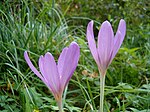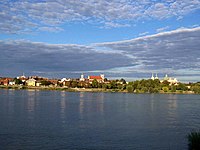Börzsöny
| Börzsöny | ||
|---|---|---|
|
The Börzsöny seen from the castle ruins of Nógrád (view to NW) |
||
| Highest peak | Csóványos ( 938 m ) | |
| location | Pest and Nógrád counties , Hungary | |
| part of | Northern Hungarian Central Mountains | |
|
|
||
| Coordinates | 47 ° 50 ' N , 18 ° 56' E | |
| surface | 400 km² | |
The Börzsöny [ ˈbørʒøɲ ] (German Pilsen Mountains , Slovak Brežany ) is a part of the Northern Hungarian Central Mountains in the Subcarpathian Mountains . It is of volcanic origin. The highest peaks of the Börzsöny are located on a former crater rim, including the Csóványos ([ ˈʧoːvaːɲoʃ ]), which forms the highest elevation in the low mountain range at 938 m. The area extends over about 400 km² and includes parts of Pest and Nógrád counties . Most of the area, known for its large number of natural springs, is a nature reserve.
history

The current shape of the Börzsöny was formed during the Miocene 18-19 million years ago. It consists mainly of volcanic rock. Sedimentary rocks can be found on the edge of the low mountain range and on the south side of the basin . The original shape was severely eroded by the effects of the subtropical climate that once prevailed .
People settled in this area thousands of years ago. The traces of their presence are still visible today. Numerous churches and castles from later times can be found in the area, including the Drégelyvár , Hont vára , Ipolydamásdi vár or the Nógrádi vár .
topography
The Börzsöny can be divided into four parts: Magas-Börzsöny ("High Pilsen Mountains"), Észak-Börzsöny ("Northern Pilsen Mountains"), Nyugat-Börzsöny ("Western Pilsen Mountains") and Déli-Börzsöny ("Southern Pilsen Mountains").
Magas-Börzsöny
The middle part of the Börzsöny was formed during the phase of highest volcanic activity. The ridge extends in a north-south direction. The highest peaks belong to it:
- Csóványos (938 m)
- Magos-fa (916 m)
- Nagy-Hideg-hegy (865 m)
- Nagy-Inóc (813 m)
Észak-Börzsöny
In the north of the Magas-Börzsöny the Kemence -Bach forms the border to the northern part. Its genesis is less clear. The area can be further divided into two main parts separated by a valley. The northern part consists largely of sedimentary rock that was formed before the volcanic activity. In the south, on the other hand, lava rock is the predominant subsurface material.
Nyugat-Börzsöny
The western part of the low mountain range was formed by former stratovolcanoes and shield volcanoes . These peaks usually reach a height of about 600 m.
Déli-Börzsöny
In the south, sedimentary rocks are typical. Here the Danube forms the border with the Visegrad Mountains .
Waters
Thanks to the high rainfall , the Börzsöny is characterized by a pronounced abundance of water. The hydrogeographic center runs towards the highest massif of the Csóványos. From there arise the most important water-bearing streams, z. B. the Kemence-patak , the Fekete patak ("Black Stream") or the Szén patak ("Coal Stream"). Because of the geological conditions and the associated nature of the surface, the above-ground watercourses are usually short and carry little water.

At 25.6 km, the longest and largest creek with constant water is the Kemence creek. The name is derived from the Slavic word kamica , which means something like "stony river bed". It rises from the springs on the eastern side of the Csóványos. The water catchment area is 107 km², the mean flow rate is 294 l / s.
Due to the density of the forest cover, almost 60% of the precipitation evaporates in the forest. Most of the watercourses are not fed by the unstable and only small amounts of water producing sources , but from the snowmelt, from the regular rainfall and the heavy summer thunderstorms. The rapid changes in the water level , which can often be observed , result from the low water capacity of the streams, which in turn stems from the volcanic underground rock. In contrast to karstified limestone mountains, precipitation does not seep into the deeper areas of the rock material.
Of the 427 natural springs registered in the cadastre , around 350 carry significant amounts of water. These can be classified into three main types:
- Valley springs that arise from the sedimentary rock at a mountain foot
- Layer sources which protrude from the most steeply sloping flank
- Fissure sources emerging from crevices inside the mountain
The last type is one of the Börzsöny's special natural treasures. About 40 of the permanent fissure springs are located at 600 m above sea level . The highest spring is at an altitude of 850–900 m.
There are no large standing water bodies of natural origin in the mountain landscape . In some areas, more and more streams are dammed in the valleys with dams. In this way, artificial lakes that fulfill various functions are created. The so-called bomb craters from the Second World War should also be mentioned. Today they are important as humid habitats of anthropogenic origin.
Among the rare natural stagnant bodies of water, the temporary lakes are worth mentioning, especially when the snow melts and in periods of high rainfall. This can be observed , for example, in Nagy-rét ("Great Au") located between Só-hegy ("Salt Mountain") and Nagy-Sas-hegy ("Big Eagle Mountain") .
Flora and fauna
Most of the Börzsöny is covered by spruce forest, but there are also tall ash trees , elms and maples . In the undergrowth , numerous species hide such. B. Primroses , the perennial silver leaf or the real daphne . Various types of flowers and grass alternate on the mountain meadows. The golden oats (see list of Germany's vascular plants ) and snow-white grove are dominant .
The area's rich wildlife also includes large game stocks, including red deer , wild boar , roe deer and mouflon . Often come pheasants , foxes , hares , badgers , martens , weasels and otters before. The birds of prey include the eastern imperial eagle , the saker falcon , the sparrowhawk and the hawk . The most famous songbirds are the nightingale , the blackbird and the lark . Most of the animal species that live in Börzsöny are protected, e. B. the fire salamander , the alpine buck or the Pyrenean mountain dog used as a shepherd dog .
tourism
From the Csóványos a panorama extends over the Danube Bend . The area around the mountain is also interesting from an archaeological point of view. The already mentioned remains of early human settlements were found there. The mountain can be reached from several directions.
- From Verőce there are hiking trails both south and west.
- From Kismaros you can take the Királyréti Erdei Vasút , one of the narrow-gauge railways, to Királyrét .
- Coming from Verőce-Magyarkút in the west, the summit can be reached by train to Diósjenő .
There are also opportunities for winter sports in Börzsöny. There is a ski slope on Nagyhideghegy . After Bánkút in the Bükk , the snow remains there for the second longest in Hungary.
Small villages like Nagybörzsöny offer different sights. There you can visit the “Church of St. Stephen” ( Szent István-templom ) from the 13th century, as well as a church built around 1700 by miners. A water mill from the 19th century has survived, the wheel of which is still driven by the waters of the Börzsöny. A museum was set up in Zebegény to commemorate the painter István Szőnyi (1894–1960), whose main subjects were motifs from the surrounding area and the everyday life of farmers. There is also a Trianon monument there. Also worth mentioning is Márianosztra , the pilgrimage site of the Magyarok Nagyasszonya ("Madonna of Hungarians"), to which pilgrimages take place on the first weekend of July, September and December . The Börzsöny Museum in Szob has an ethnographic and a natural history collection. The permanent collection includes more than 24,000 pieces. The exhibition, opened in 1960, offers insights into the history of the place and the surrounding area from the New Stone Age to the Ottoman Period.
In the Börzsöny, the area can be explored with various narrow-gauge railways :
- Királyréti Erdei Vasút ("Királyrét Forest Railway")
- Nagybörzsönyi Erdei Vasút ("Nagybörzsöny Forest Railway")
- Kemencei Erdei Múzeumvasút ("Kemence Museum Forest Railway")
Municipalities in Börzsöny
- Bernecebaráti , Ipolydamásd , Ipolytölgyes , Kemence , Kismaros, Kóspallag , Letkés
- Márianosztra, Nagybörzsöny, Nagymaros , Nógrád , Nőtincs , Perőcsény , Rétság
- Szob, Szokolya , Tésa , Verőce , Vác , Vámosmikola , Zebegény
Web links
- Northern castles and chateaux (Börzsöny-Cserhát). The bicycle travel database, accessed on November 18, 2008 (German).
- Egy ködös nap a Dunakanyarban (“A foggy day on the Danube Bend”). Picasa Web Album, December 7, 2007, archived from the original on April 29, 2016 ; Retrieved November 18, 2008 (Hungarian).






